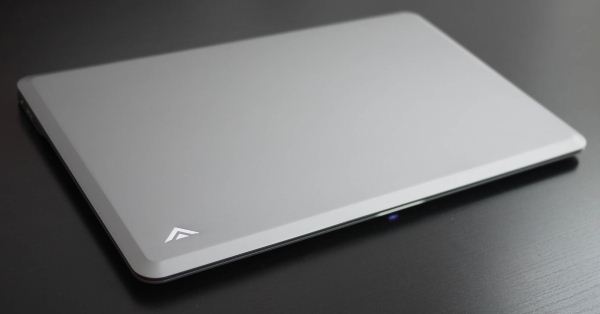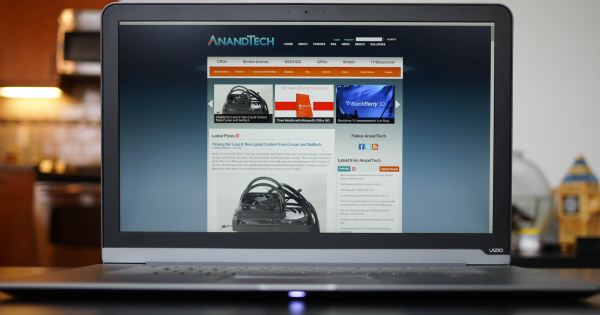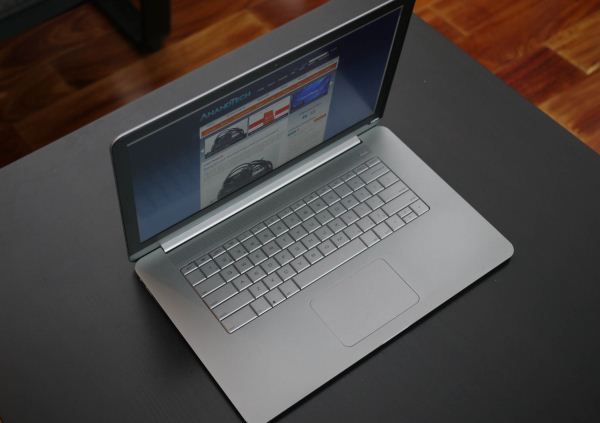Vizio Thin+Light CT15: Something New and Edgy
by Vivek Gowri on February 14, 2013 9:00 AM EST- Posted in
- Laptops
- Intel
- IPS
- Ivy Bridge
- Vizio
- Ultraportable
- Ultrabook
The Vizio is clean and sleek, really a notebook that looks like it was designed by actual industrial designers. This should be a pretty foregone conclusion, but there’s a large number of notebooks out there that don’t look like designers had any say in the designs, especially at the lower end.
The aesthetic is crisp and the entire notebook is very unadorned. There’s nothing glossy on this notebook—not the display, bezel, nor any of the aluminum or the soft touch plastic pieces that make up the chassis. It’s fantastic and I love it.
The body is a single piece of anodized aluminum with a gunmetal finish and the bottom half of the casing is soft-touch plastic. The lid is almost entirely clean, with a small Vizio logo in the top left corner. In profile, the notebook is mostly flat, with tapers at the front and side edges to enhance the perception of thinness. It’s a neat design trick, but I feel like it’s starting to be overused in the world of thin (and not so thin) notebooks. The sides have small portions that are flat, in order to house the meager assortment of ports. The flat part continues across the back of the notebook where the hinge is.
The bezel around the display is perfect—dark plastic with a matte finish, relatively thin, webcam and mics centered above the display, thin aluminum band at the bottom, and a very small Vizio logo at the bottom left corner. Whoever designed it could teach a course on notebook interior design that a lot of other notebook manufacturers could really benefit from.
I’m a fan of where Vizio has gone with their industrial design language, though there’s some refinement that remains on the build quality side of things—the anodization is noticeably coarser than what you find on recent Apple or ASUS devices, while the edges are sharper and more abrupt than they should be. I’ve seen variable build quality between units, with greater degrees of variance in the panel gaps and fit of the keyboard and touchpad. They’re glitches for sure, all signs that point to Vizio being very new to the PC hardware game still, but these are all relatively minor details that they should pick up on and fix as they move forward
Being only 0.68” thick and weighing less than 4 pounds, the CT15 is still slightly bulkier than the smaller and more svelte S9 15” (0.58”, 3.63lbs). Something about the ultrathin 15” form factor, like the Vizio and Samsung, as well as things like the Retina MacBook Pro 15” and the ASUS Zenbook U500, is very aesthetically appealing even though they lack the out-and-out portability of machines with smaller footprints. Even with the superlight weights in play here, the increased size makes this class of system more difficult to use in cramped spaces (such as a plane or lecture hall desk). But damn if they don’t look fantastic.
There’s one huge flaw in this entire design that I’ve been rhapsodizing about though. Surprisingly, it’s not the touchpad—the Sentelic pad that plagued the first run of Windows 7-based Vizio systems has been chucked in favor of a Synaptics unit that’s an absolute breath of fresh air in comparison. Nobody was lying to you, the Sentelic pad actually made the CT15 downright unusable, especially in comparison with the increasingly stellar Elan and Synaptics pads. Sure, they aren’t Apple, but they’re close. The Sentelic was closer to the dark ages for PC touchpads and the series of misguided buttonless pads used by HP and Dell. (Interestingly, my last experience with Sentelic was with the Dell Inspiron 11z from the CULV days. It had a similarly awful touchpad.) But that’s history, and thankfully we have Synaptics and their multitouch gesture suite.
No, the real issue here is the keyboard as well as the metal surrounding it. The keyboard was a problem spot before, too, and hasn’t been fixed. It’s one of the few notebooks that I’ve seen in the last four or five years without a chiclet style keyboard. Even the ThinkPad line, that bastion of old-school notebook design, has moved into the modern world, so it was a bit odd to see the older style of keyboard on this. But I have no quarrel with the keyboard style; the flatness seemed to go well with the rest of the industrial design. Unfortunately, there’s way too much flex involved, and not just in the keyboard itself. The interior aluminum flexes heavily as well, which is odd and indicates a very thin chassis material used. The display also exhibits a bit more flex than I would like, though it’s not a day to day issue like the keyboard and interior is. It’s pretty bad, and a major oversight for a company that seemed to be so detail oriented with the rest of the design.
The upcoming Thin+Light looks basically the same as the current one, but goes a long way towards fixing the interior flex. They made the interior aluminum panel a bit thicker, paired with a stiffer keyboard, and made all the build quality related issues go away. The typing experience is significantly better, though I still think they should move to a chiclet keyboard. You do get used to the flex in the current-gen CT15; it’s not a dealbreaker like the touchpad was previously, but it definitely does detract somewhat from the user experience.














55 Comments
View All Comments
rangerdavid - Thursday, February 14, 2013 - link
Soldered-on is pretty standard in these thin form-factors. Yes, 6 or 8 would be nice, but removable means thicker in most cases. No pun intended. Wait, no; intended.blueboy11 - Friday, February 15, 2013 - link
LOL! Yeah, the damned soldered unremovable RAM that should've been upgraded to 8GB in the first place! What the hell where they thinking in the first place? Oh wait, they weren't!!MobiusStrip - Sunday, February 17, 2013 - link
Just because a rip-off has become standard doesn't mean we should accept it.Apple has led the way in degrading its computers with soldered-in RAM, glued-together chassis and now shitty laptop drives in its desktop computers. We should not give them or any other manufacturer a free pass on this crap.
PeteH - Wednesday, March 6, 2013 - link
I honestly don't think manufacturers are doing things like soldering down RAM to rip people off, I think they're doing it because that's the only way to get the form factor.The problem is that consumers continue to endorse trading flexibility for pretty industrial design (based on what they buy). Manufacturers are just giving the consumers what they want, and it's hard to fault them for it.
Ninhalem - Thursday, February 14, 2013 - link
When do you need more than 4 GB of RAM? If this is used as a non-gaming notebook I don't think you will ever need more than 4 GB for a regular notebook (the HD 4000 already guarantees that this isn't a gaming oriented notebook).I'm running a desktop at the moment with only 4 GB of RAM with about 5 applications open (including Adobe running a big file) and only using about 1.7 GB.
Actually this notebook is a slam dunk for me. I've been crawling the internet for a notebook with these specs for my father to use as a research (history) tool when he goes overseas.
I just don't think the perception of 4GB is not enough is viable here.
halo37253 - Thursday, February 14, 2013 - link
Tell me what you need more then 4gb of ram for?I have 6GB of RAM in my main system and have never had a program fill it other then p95 while stressing. Really unless the user is running VM crazy or is going crazy in some adobe program I think the user is more then set with 4gb.
RAM does not make your PC faster if you don't need it, no one using a laptop like this with no GPU to load advance compute or even games onto. Though even for gaming you don't need more then 4gb.
4GB in my gaming HTPC and 6GB in my main system, both always has RAM left.
I would rather have them take the 256gb SSD out of this laptop and toss in a 128gb m-sata chip and toss in a HDD for user storage. For SSD you only need some apps and OS on your SSD. Pretty much all user files in the c:\users\yourname can be moved onto the HDD for more storage. Do the same thing with my laptop and desktop, but with sata SSD not msata. No point to have movies, music, games installed onto the SSD.
themossie - Thursday, February 14, 2013 - link
Chrome can easily use more than 4 gigs of ram with a minimal set of extensions.6 gigs used right now (2 more cached) out of 8 gb on my old Arrandale Studio XPS 16. Notepad++ and two web browsers with 50 tabs open, flash disabled and minimal extensions.
How could I upgrade to a machine with less RAM? Many people can sacrifice processing power for battery life and form factor, but not RAM - especially given how cheap it is these days.
themossie - Friday, February 15, 2013 - link
Also - 4 years ago (early 2009), the entry-level config of the earliest version of my laptop (Core 2 Duo) came with 4 gigs of ram.It had the same $1100 MSRP at the time, though definitely not an ultrabook - weighing 2.5 lbs more:-)
seapeople - Sunday, February 17, 2013 - link
Browsers allocate far more memory than they actually use, and are programmed to trim this allocation with virtually no impact to performance once the memory is needed elsewhere in the system.So even though your Chrome may routinely report a use of 4-6 gb on your 8 gb system, if you only had a 4 gb system then Chrome would likely purr along just the same while using only 2-3 gb of RAM. Perhaps once every four days when you switch over to tab number 80 it will take 2 seconds for Chrome to pull up the picture at the bottom of the page on this tab, which you would only even notice if you switched to that tab and immediately hit Ctrl-End.
Not to mention that hibernating a system with 8 gb of RAM will take significantly longer than one with 4 gb of RAM...
cbf - Thursday, February 14, 2013 - link
Software Development.Visual Studio, local ASP.NET server (for debugging), and connection to large databases.
Also, certain CAD work. Normally one would say you need a workstation class laptop with Quadra or FirePro onboard, but frankly Intel HD4000 graphics is pretty close to where mobile Quadra or FirePro was a few years ago, and works OK with a lot of CAD packages now.